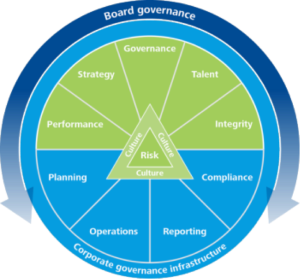The Deloitte Centre for Corporate Governance recently published the third edition of “The Effective Not-for-Profit Board. A Value-driving Force” (you can download a copy by going to http://www.corpgov.deloitte.com/site/CanEng and clicking on the Deloitte Publications tab). This publication is particularly helpful for Canadian non-profits because it is produced from a Canadian perspective. Deloitte builds its philosophy of non-profit governance on this premise: “the board bears the ultimate responsibility for the stewardship of an organization”(1). Their motivation in providing this publication is the conviction that “well-governed organizations have proven to be more effective, and more likely to succeed, than poorly governed ones”(4).
Within Canadian contexts most church congregations are organized as charitable, private non-profits and so much of Deloitte’s advice, with appropriate adjustments, applies to governance within congregational life. Their publication discusses five elements (1):
1. It examines “the meaning of good governance, and its relevance” to non-profits.
2. It presents the Deloitte Governance Framework “which reflects current and emerging governance best practices.”
3. It provides “a detailed discussion of element of this ‘governance framework’.”
4. It considers challenges specific to non-profits and how to address them.
5. It concludes with various tools that can assist boards in carrying forward their responsibilities.
Central to their presentation is this thesis: “the objective of good governance is to ensure that the organization achieves its objectives by being able to put forth its best efforts to implement its strategies and make the best use of its resources” (5). Translated into the context of a congregational entity this would mean that governing boards in churches because of their commitment to God bend every effort to ensure that the congregational mission and vision are being achieved by implementing effective ministry strategies and stewarding available resources in the best way.
The Deloitte® Corporate Governance Framework (Copyright Deloitte®) summarizes how in their view effective governance operates within a non-profit. The top five areas comprise a board’s primary responsibilities, but in smaller non-profits in which the board may have to assume some management responsibilities some of the elements in the lower half of the schematic may also have to be included. Normally these would be management responsibilities. I am not sure I would put “risk” at the centre. From my perspective central is the congregation’s mission. Risk management then becomes one of the key responsibilities of board governance. Board culture certainly influences everything.

They suggest that a critical document every board should have is a formally adopted statement of mandate. This “sets out the responsibilities of the board and its committees, particularly those decisions that require the approval of the board”(6). They provide an example of such a document in Appendix A. Sample Mandate for an NPO Board (38-39). If your church board has not prepared such document which it can share with stakeholders and the general public, then it would be an important goal in 2014 to put such in place.
They do have a section related to board chairs. They affirm that “the choice of who will chair the board is one of the most important decisions a board will make since the effectiveness of the board and its chair is generally synonymous”(21). This perspective is quite refreshing to see because often within church board governance this reality is neither understood or appreciated. In their view “the board chair must possess all of the traits and capabilities of a good board member. In addition, the chair must be able to provide leadership and convey the board’s ‘vision’ to management and the non-profit’s stakeholders”(21). I have added the bold font to emphasize this aspect of a church board chair’s role.
This is a first-class piece of work and deserves careful scrutiny by church board chairs. It provides a wealth of information and understanding about governance — “the processes and structures used to direct and manage an organization’s operations and activities. It defines the division of power and establishes mechanisms to achieve accountability among stakeholders, the board of directors and management”(4).
